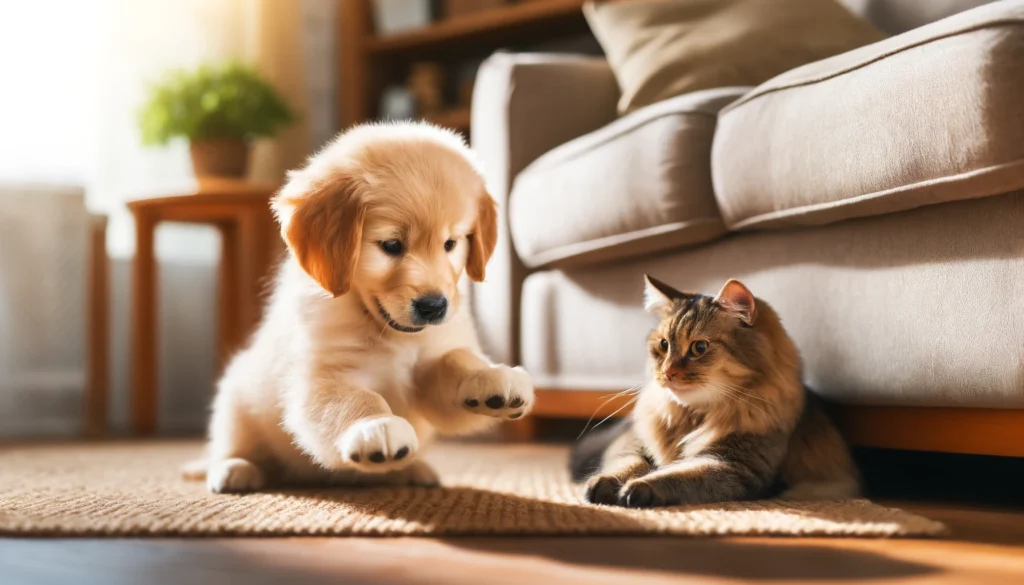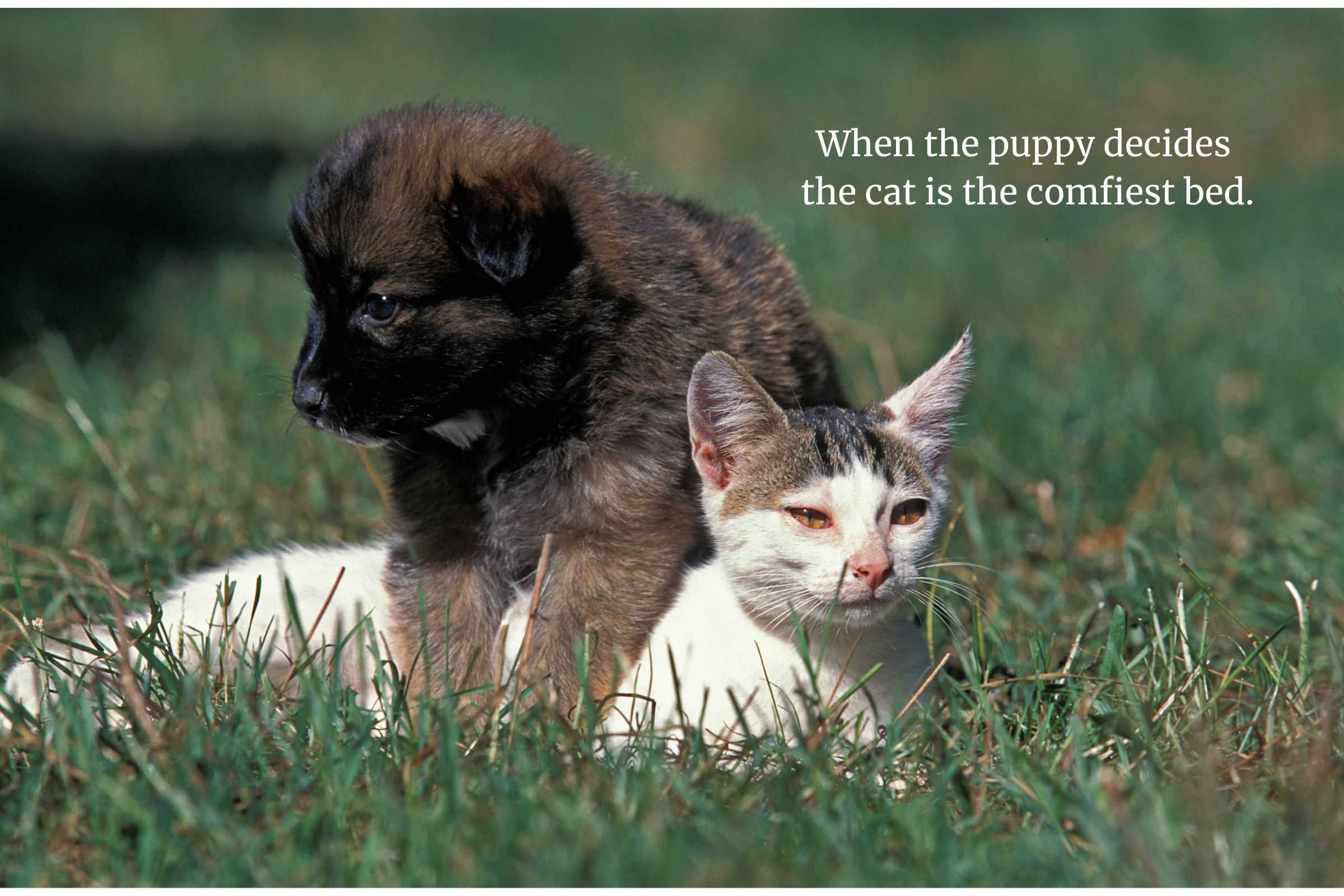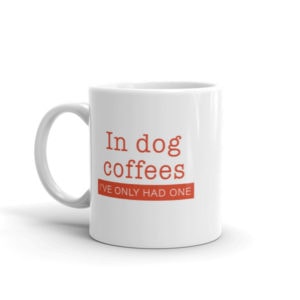This post may contain ads and affiliate links and we may earn a small commission when you click on the links at no additional cost to you. As an Amazon Affiliate, we earn from qualifying purchases. You can read our full disclaimer here.
Introducing a Puppy to a Cat: Ultimate Guide to Smooth Transitions

Introducing a puppy to a cat can be an exciting journey filled with adorable moments. But it’s not without its challenges.
This pivotal time can set the tone for their future relationship, highlighting the need for a thoughtful and gentle approach.
Ensuring a smooth transition requires patience and careful introduction, crucial steps towards creating a harmonious household.
Remember, the goal is to build a positive foundation for their interactions. This paves the way for a friendship that enriches your family’s life.
Check out this super cute clip where our little Golden Retriever pup, Daisy, is all about trying to get our chill Maine Coon cat to play.
It’s all tail wags and playful nudges from the pup, trying to stir up some fun with the cat. It’s just adorable how she’s working so hard to get the cat to play with her!
Introducing a Puppy to a Cat: Preparing Your Home for the New Arrival
Before introducing a puppy to a cat, it’s essential to prepare your home and set the stage for a positive relationship between your furry family members.
Creating a welcoming and safe environment is key to easing the transition and minimizing stress for both pets.
Preparing Your Home for the New Arrival
Start by puppy-proofing your home and ensuring that your cat has high perches and escape routes in every room.
This not only keeps your puppy safe from potential hazards but also gives your cat the sense of security they need.
Consider installing baby gates to create separate zones, allowing each pet to have their own territory.
Ensuring Both Animals Have Their Own Safe Spaces
Designate a safe space for each pet where they can retreat and relax without being disturbed.
For your cat, this might be a room with their bed, litter box, and toys, accessible only by a small door or gate that the puppy cannot pass through.
For the puppy, a crate or a specific area with their bed and chew toys will provide a sense of safety and belonging.
The Significance of Scent Swapping Before the Face-to-Face Meeting
Scent plays a crucial role in how pets perceive and accept each other. Before the actual introduction, exchange bedding or toys between the puppy and the cat to familiarize them with each other’s scent.
This scent swapping helps reduce anxiety and builds a foundation of familiarity, making the first face-to-face meeting less intimidating.
By taking these preparatory steps, you lay the groundwork for a smoother introduction. It helps reduce potential friction and promotes a peaceful coexistence.
The initial effort you put into preparing your home and pets for this new chapter can significantly impact the ease and success of integrating your puppy and cat.
The First Time Introducing a Puppy to a Cat
When the moment arrives to introduce your puppy to your cat, managing their first encounter carefully is crucial for a positive start to their relationship.
A calm and controlled introduction can set the tone for their future interactions, helping both pets feel secure and understood.
Managing the First Encounter
For the initial introduction, choose a neutral space where neither pet feels territorial.
Keep the puppy on a leash to control their movements, ensuring they don’t overwhelm the cat. Allow them to see and sniff each other from a distance, gradually decreasing the space between them based on their reactions.
Don’t forget, short and positive sessions are key, ending the interaction before any signs of stress escalate.
The Role of Barriers and Controlled Environments

Barriers, such as baby gates or a transparent door, can be incredibly helpful during the first few encounters. They allow the puppy and cat to observe and interact with each other safely, minimizing the risk of a negative experience.
Controlled environments help both animals acclimate to each other’s presence without the pressure of direct contact, laying the groundwork for a gradual and successful introduction.
Observing Body Language and Signs of Stress
Understanding and interpreting the body language of your pets is essential during their initial meetings. Look out for signs of stress or aggression, and be ready to intervene if necessary.
| Signs of Stress in Cats | Signs of Stress in Puppies |
|---|---|
| Hissing, growling, or spitting | Whining or barking |
| Flattened ears | Tucking the tail |
| Swishing or thumping tail | Avoiding eye contact |
| Attempting to hide or escape | Pacing or restlessness |
| Dilated pupils | Lip licking or yawning |
Both cats and puppies express discomfort or stress through their body language.
Recognizing these signs early can prevent negative experiences that could hinder their ability to form a positive relationship.
Always prioritize their comfort and end the interaction on a positive note, using treats and praise to reinforce good behavior.
Gradual Integration when Introducing a Puppy to a Cat

Gradual integration is key to fostering a positive relationship between your puppy and cat.
By carefully managing their time together and ensuring each interaction is positive, you can help them build trust and comfort with one another.
Patience is crucial; rushing the process could lead to setbacks in their relationship.
Steps for Gradually Increasing Their Time Together Under Supervision
- Start with Short, Supervised Sessions: Begin with brief encounters while keeping the puppy on a leash, gradually increasing the duration as both animals become more comfortable with each other.
- Use Positive Reinforcement: Reward both pets with treats and praise for calm and curious behavior around each other, reinforcing positive interactions.
- Create Controlled Situations: Continue using barriers when unsupervised, gradually removing them as their comfort with each other grows.
- Keep Distractions Handy: Have toys or treats ready to redirect attention if either pet shows signs of stress or aggression.
- Observe Body Language: Watch for signs of relaxation or tension, adjusting the environment and duration of their meetings accordingly.
Tips for Encouraging Positive Interactions
- Maintain Routine: Keep both animals’ routines as stable as possible to avoid added stress.
- Introduce Common Scents: Continue scent swapping by using blankets or toys to carry each pet’s scent to the other.
- Provide Escape Routes: Ensure your cat always has a way to retreat from the puppy if they feel overwhelmed.
- Engage in Parallel Play: Play with the cat and puppy simultaneously but separately, helping them associate each other’s presence with positive experiences.
- Use Feeding Time to Your Advantage: Feed them on opposite sides of a door or barrier to build positive associations.
- Be Patient and Consistent: Consistency in your approach will help both pets understand what to expect, reducing anxiety.
- Monitor Playtime: Ensure play is gentle and stop any rough behavior immediately.
- Gradually Increase Shared Space: As they grow more comfortable, allow them to share more common spaces under your supervision.
- Celebrate Small Wins: Acknowledge moments of peaceful coexistence with treats and praise.
- Seek Professional Help if Needed: If tensions rise, consider consulting a pet behaviorist for guidance.
The Importance of Not Rushing the Process
Rushing the integration process can undo progress and potentially harm the relationship between your puppy and cat. Each pet is unique, and their timeline for acceptance will vary.
Maintaining Harmony when Introducing a Puppy to a Cat
Achieving a peaceful coexistence between your puppy and cat goes beyond the initial introduction period. It requires ongoing effort and strategies to maintain harmony in your household.
Understanding the dynamics of their relationship and making adjustments as needed can ensure both pets live together comfortably.
Ongoing Strategies for a Peaceful Coexistence
- Respect Personal Space: Ensure each pet has their own safe haven where they can retreat and relax without the other’s intrusion.
- Continue with Positive Reinforcement: Regularly reward both pets for peaceful coexistence and non-aggressive behavior towards each other.
- Establish and Maintain Routines: Consistent routines for feeding, playtime, and rest help reduce anxiety and prevent territorial disputes.
- Monitor Interactions: Keep an eye on their interactions, especially in situations that could lead to competition or jealousy, such as during meal times or play.
- Engage in Joint Activities: Encourage activities that both pets can enjoy together, such as walks with the puppy on a leash and the cat in a secure harness, if they are comfortable with it.
The Importance of Separate but Equal Attention to Prevent Jealousy
Jealousy can be a significant issue in multi-pet households, leading to tension and conflicts. To prevent this:
- Allocate individual time with each pet, ensuring they receive equal affection and attention.
- Celebrate their uniqueness by engaging in activities tailored to each pet’s preferences.
- Be mindful of your body language and actions to avoid showing favoritism.
Adjusting Routines as Needed to Accommodate Both Pets
Flexibility in your daily routine can greatly contribute to a harmonious environment:
- If one pet requires more attention or care at certain times, find ways to compensate the other to prevent feelings of neglect.
- Adjust feeding times and locations if competition arises, ensuring each pet can eat peacefully.
- Incorporate new activities or toys that encourage mutual curiosity and play, reducing boredom and potential rivalry.
Maintaining harmony between a puppy and a cat is an ongoing process that evolves as they grow and their relationship develops.
The Comical Side of Coexistence: Puppies and Cats Together
When puppies and cats share a home, their antics can provide endless entertainment and laughter. The curiosity and playful nature of these two very different animals can lead to some hilarious moments, showcasing the lighter side of their budding friendship.
Here are a few funny things puppies and cats do together that pet owners have joyously observed:
- The Great Chase: Puppies love chasing cats, but are often left puzzled when the cat leaps to a high shelf, disappearing from sight.
- Mistaken Identity: Puppies sometimes think a cat’s tail is a toy, leading to surprised jumps and puzzled looks.
- The Unexpected Cuddle: Despite size differences, puppies and cats often cuddle up, especially amusing when the puppy outgrows the cat but still seeks cuddles.
- Mealtime Mischief: Puppies trying to sneak cat food—and sometimes vice versa—results in a funny dance of stealth and cunning.
- The Toy Tug-of-War: What starts as a battle over toys often turns into playful sharing, forgetting the fight in favor of fun.
- Learning from Each Other: It’s hilarious to see puppies attempting to use litter boxes or cats trying to bark, mimicking each other’s habits.
- The Stare-Down: Silent moments of staring each other down break into playful skirmishes, highlighting their curious and playful nature.
These funny moments not only provide laughter and joy but also deepen the bond between pets and their families. Watching puppies and cats interact, with their distinct personalities and behaviors, reminds us of the joy and spontaneity pets bring into our lives.
Wrapping Up Introducing a Puppy to a Cat
In conclusion, the blend of antics, cuddles, and shared moments between puppies and cats enriches our lives, reminding us of the joys of pet companionship.
As they grow together, these furry family members create a tapestry of laughter and love, turning everyday into a delightful adventure.
-

Coffee Mug – In Dog Coffees I’ve Only Had One
Price range: $11.95 through $14.95 Select options This product has multiple variants. The options may be chosen on the product page
